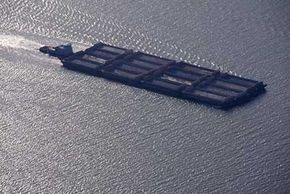Boats, from a small toy boat to a cruise ship to a massive cargo ship, manage to stay afloat on water. How do boats float? Archimedes first recorded the standard definition of floating.
The Archimedes Principle states that an object in a fluid experiences an upward force equal to the weight of the fluid displaced by the object. So if a boat weighs 1,000 pounds (or kilograms), it will sink into the water until it has displaced 1,000 pounds (or kilograms) of water. Provided that the boat displaces 1,000 pounds (or kilograms) of water before being submerged, the boat floats. If not, the ship sinks.
Advertisement
It is not very hard to shape a boat in such a way that the weight of the boat has been displaced before the boat is completely underwater. The reason it is so easy is that a good portion of the interior of any boat is air (unlike a cube of steel, which is solid steel throughout). The average density of a boat — the combination of the steel and the air — is very light compared to the average density of water. So very little of the boat actually has to submerge into the water before it has displaced the weight of the boat.

